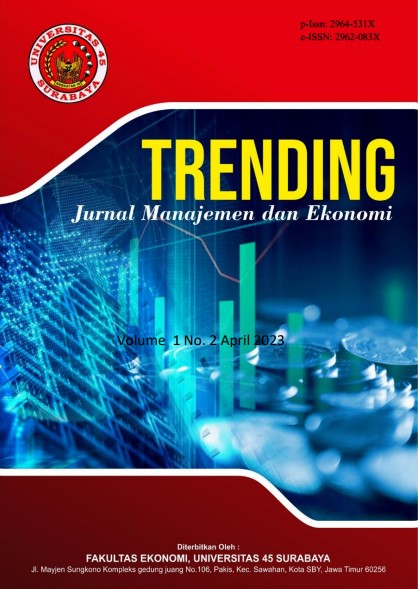Analisis Pengendalian Kualitas Produk dengan Metode Statistical Process Control Pada PT Glory Industrial di Sragen
DOI:
https://doi.org/10.30640/trending.v2i4.2971Keywords:
Check Sheet, Control Chart, Fishbone, Pareto Diagram, Product Quality Control, Statistical Process ControlAbstract
The aim of this research is to analyze the production quality control policy at PT Glory Industrial in Sragen, to identify the factors that cause damage and loss to products produced by PT Glory Industrial in Sragen. This research is included in the type of case study research at PT Glory Industrial in Sragen by conducting a survey to the company. This research only covers production quality control at PT Glory Industrial in Sragen. Product quality control uses the Statistical Process Control method. Starting with determining quality standards then production results, then damaged production is analyzed through quality control using Statistical Process Control, so that you can receive analysis results that can be useful for PT Glory Industrial in Sragen. The results of the research show that the implementation of product quality control at PT Glory Industrial has not been under control, this is proven by the production process that there were 4 points that exceeded the upper control limit (UCL) and lower control limit (LCL). Occurred on the months February (0,023), June (0,084), September (0,022) and November (0,075). From this data, it can be seen that there are still those who exceed the control limits, thus indicating that quality control has not been implemented properly and improvements are needed to overcome these deviations. Thus H1 is proven correct, there are 6 types of damage that occur at PT Glory Industrial, namely looseness, broken fabric, embossed threads, skipped threads, damaged stitching and wrong labels. Based on the causes and effects, the factors that cause damage are human factors, machines, materials and work methods. Thus H2 is proven correct.
References
Abtew. (2015). Manajemen kualitas. Surabaya: Dinamika Aksara.
Adita, P. S. (2023). Analisis pengendalian kualitas dengan metode Statistical Process Control (SPC) dalam meningkatkan kualitas produk baju di Kalimantan. Autex Research Journal, 1(2), 160–172.
Aminato, S. (2019). Mengelola kualitas dengan Statistical Process Control. Surabaya: Permata.
Anonim. (2016). Pedoman penyusunan usulan penelitian dan skripsi Fakultas Ekonomi, Edisi Revisi Ketujuh. Surakarta: FE-UNISRI.
Arikunto, S. (2016). Pengembangan instrumen penelitian dan penilaian program. Yogyakarta: Pustaka Pelajar.
Asiana, S. (2020). Manajemen (Edisi 2). Yogyakarta: BPFE.
Astuti, R. D. (2020). Implementation of Statistical Process Control to reduce defects in textile product (Case Study at PT. Petra Sejahtera Abdi). Journal of Applied Business Administration, 1(5), 80–95.
Bakhtiar. (2019). Metode Statistical Process Control (SPC). Surabaya: Rendika Utama.
Bardia. (2020). Pengendalian kualitas: Modul 01-Pengendalian kualitas. Jakarta: Universitas Mercu Buana.
Crosby. (2019). Manajemen operasi untuk perusahaan: Dari teori ke praktik, Edisi Ketiga. Jakarta: Raja Grafindo Persada.
Dedy, S. (2022). Analisis pengendalian kualitas produk untuk meminimumkan produk gagal pada pabrik tekstil Tetoron Rayon di Semarang. Jurnal Pendidikan Ekonomi Undiksha, 10(2), 637-645.
Deming. (2022). Pengantar teknik industri (Edisi Kedua). Yogyakarta: Graha Ilmu.
Erina, D. P. (2022). Analisis pengendalian kualitas (Statistical Process Control) untuk meningkatkan kualitas produk yang dihasilkan pada CV Bina Tekstil. Jurnal Ilmiah Teknik Industri, 5(2), 87-99.
Fadhlirrobi, S. (2021). Analisis pengendalian kualitas (Statistical Process Control) dalam meningkatkan kualitas produk (studi kasus rumah produksi kaos kaki di Samarinda). International Journal of Information and Education Technology, 1(3), 303–310.
Feigenbaum. (2017). Statistical Process Control and Quality Improvement Third Edition. New Jersey: Prentice-Hall.
Frizal, S. (2022). Analisis pengendalian kualitas produk T-Shirt dengan menggunakan metode Statistical Process Control (SPC) untuk meminimumkan jumlah produk cacat di pabrik garmen. Malikussaleh Industrial Engineering Journal, 1(4), 29–36.
Garvin. (2018). Convenience and fast food handbook. USA: The Avi Publishing Company Inc.
Hammas. (2021). Manajemen produksi pengendalian produksi Buku 1 (Edisi Keempat). Yogyakarta: BPFE.
Hariningrum. (2020). Analisis pengendalian kualitas produk dengan menggunakan Statistical Process Control (SPC) pada usaha amplang Karya Bahari di Samarinda. Jurnal Ilmiah Teknik Industri, 1(3), 134–138.
Heizer, J., & Render, B. (2017). Manajemen operasi. Jakarta: Salemba Empat.
Irwan, & Satrio. (2020). Analisis Statistical Process Control pada pengendalian produk jaket kulit di Safe Industri. Jurnal Ilmiah Teknik Industri, 12(5), 87.
Kaban. (2016). Mengelola kualitas dengan Statistical Process Control. Surabaya: Media Utama.
Kadim. (2021). Kendali mutu terpadu. Jakarta: Erlangga.
Nasution. (2021). Quality management in the Bosch Group | Technical statistics 7. Statistical Process Control SPC.
Prihastono, E., & Amirudin, H. (2017). Pengendalian kualitas sewing di PT. Bina Busana Internusa III Semarang. Jurnal Ilmiah Dinamika Teknik, 10(2), 1–15.
Ridwan. (2020). Statistical Process Control (SPC): User’s Guide to Plastic, 7(3), 215–222.
Sandi. (2019). Quality control: Panduan penerapan teknis. Bekasi: Wishnu AP & Partners.
Sugiyono. (2019). Metodologi penelitian kuantitatif, kualitatif dan R&D. Bandung: Alfabeta.
Ulfa, M. (2019). Pengendalian kualitas kain pada departemen weaving dengan metode Statistical Process Control PT Sariwarna Asli Textile Industry Unit 2 Boyolali. Jurnal Ilmiah Teknik Industri, 3(1), 114–122.
Windarti. (2019). Pengendalian mutu terpadu. Jakarta: Erlangga.
Yamin, K. (2019). Total quality management (Cetakan 3). Jakarta: Gramedia.
Yuliasih, W. (2018). Manajemen industri. Jakarta: Aksara Utama.
Downloads
Published
How to Cite
Issue
Section
License
Copyright (c) 2024 Trending: Jurnal Manajemen dan Ekonomi

This work is licensed under a Creative Commons Attribution-ShareAlike 4.0 International License.








